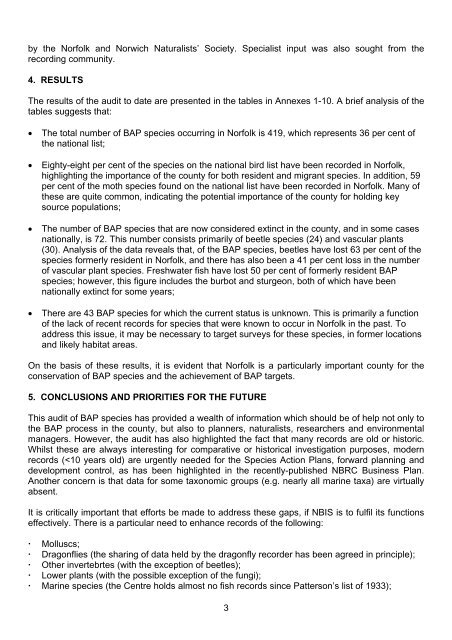NORFOLK BIODIVERSITY ACTION PLAN SPECIES DATA AUDIT ...
NORFOLK BIODIVERSITY ACTION PLAN SPECIES DATA AUDIT ...
NORFOLK BIODIVERSITY ACTION PLAN SPECIES DATA AUDIT ...
You also want an ePaper? Increase the reach of your titles
YUMPU automatically turns print PDFs into web optimized ePapers that Google loves.
y the Norfolk and Norwich Naturalists’ Society. Specialist input was also sought from the<br />
recording community.<br />
4. RESULTS<br />
The results of the audit to date are presented in the tables in Annexes 1-10. A brief analysis of the<br />
tables suggests that:<br />
• The total number of BAP species occurring in Norfolk is 419, which represents 36 per cent of<br />
the national list;<br />
• Eighty-eight per cent of the species on the national bird list have been recorded in Norfolk,<br />
highlighting the importance of the county for both resident and migrant species. In addition, 59<br />
per cent of the moth species found on the national list have been recorded in Norfolk. Many of<br />
these are quite common, indicating the potential importance of the county for holding key<br />
source populations;<br />
• The number of BAP species that are now considered extinct in the county, and in some cases<br />
nationally, is 72. This number consists primarily of beetle species (24) and vascular plants<br />
(30). Analysis of the data reveals that, of the BAP species, beetles have lost 63 per cent of the<br />
species formerly resident in Norfolk, and there has also been a 41 per cent loss in the number<br />
of vascular plant species. Freshwater fish have lost 50 per cent of formerly resident BAP<br />
species; however, this figure includes the burbot and sturgeon, both of which have been<br />
nationally extinct for some years;<br />
• There are 43 BAP species for which the current status is unknown. This is primarily a function<br />
of the lack of recent records for species that were known to occur in Norfolk in the past. To<br />
address this issue, it may be necessary to target surveys for these species, in former locations<br />
and likely habitat areas.<br />
On the basis of these results, it is evident that Norfolk is a particularly important county for the<br />
conservation of BAP species and the achievement of BAP targets.<br />
5. CONCLUSIONS AND PRIORITIES FOR THE FUTURE<br />
This audit of BAP species has provided a wealth of information which should be of help not only to<br />
the BAP process in the county, but also to planners, naturalists, researchers and environmental<br />
managers. However, the audit has also highlighted the fact that many records are old or historic.<br />
Whilst these are always interesting for comparative or historical investigation purposes, modern<br />
records (





